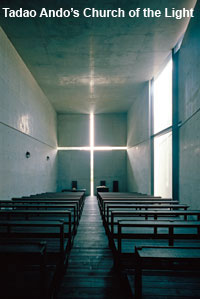I have always been moved by the power of architecture. Good architecture elevates the soul, rekindles the spirit and makes one believe in a better today and tomorrow. During my graduate student days in Boston, I was lucky to live amidst buildings like the Frank Gehry-designed Stata Center and the Eero Saarinen-designed MIT Chapel and Kresge Auditorium. I’ve also been privileged to have visited iconic structures like the Museum of Islamic Art in Doha and the Louvre glass pyramid in Paris, both designed by IM Pei, or the Jorn Utzon-designed Sydney Opera House, or Herzog and de Meuron’s Tate Modern in London, and closer home, spaces such as the Louis Kahn-designed IIM campus in Ahmedabad, the Charles Correa- designed National Crafts Museum in Delhi and the BV Doshi-designed Husain-Doshi Gufa in Ahmedabad. My experience in these spaces has sometimes moved me to silence and sometimes, to tears.
Tadao Ando’s Mumbai visit was an occasion for both of these – silence and tears. I was stunned when I first heard that he was coming to the city on a private visit as the guest of Parmeshwar and Pirojsha Godrej, and speechless when we managed to schedule a public lecture by him in the city, through the Godrej India Culture Lab. The tears came from the attendees at the talk – a blend of architects, professors, architecture students and key invitees from the city’s intelligentsia. We invited 350 guests and kept the details of the visit very low key, still about 550 showed up at the venue on the day of the talk, with many students and architects flying in from other cities like Ahmedabad and Bengaluru. Such is the power of Ando, the super-star architect who jet-sets around the world and counts among his friends people like U2’s lead singer Bono, fashion designers Tom Ford and Giorgio Armani, and artists like Yayoi Kusuma, but continues to be at heart, as I found out over the two days that I spent with him, completely child-like and simple. His Mumbai talk had the audience spell bound with its wisdom and humour and there were quite a few wet eyes in the audience as he finished.
If at this point, you’re going Tadao Ando, who, then *facepalm* and *deep sigh* and this paragraph is for you. (Everyone else can skip forward to the next one!) Tadao Ando is one of the world’s greatest living architects and the only architect to have won the discipline’s four most prestigious prizes: the Pritzker, Carlsberg, Praemium Imperiale, and Kyoto Prize. Combining influences from Japanese tradition with the best of Modernism, Ando has over the years developed a completely unique building aesthetic that makes use of concrete, wood, water, light, space, and nature in a way that has never been witnessed in architecture. He has designed award-winning private homes, churches, museums, apartment complexes, and cultural spaces throughout Japan, as well as in France, Italy, Spain, and the USA.
The unique combination of hardness and softness, of concrete and Zen-like natural surroundings, and of minimalism and breathtaking complexity, make Ando’s works very moving as well as still. What is fascinating is that Ando didn’t train as an architect. He grew up poor in Osaka, and tried different professions in his youth, including that of a professional boxer, before becoming a self-taught architect in the 1960s, and the rest, is well, architectural history.
Ando’s recent large works are extraordinary, such as the Punta Della Dogana’s renovation in Venice, Italy (a state-owned 15th-century customs house located on the shore opposite the Piazza San Marco has been converted into a museum of contemporary art), the Modern Art Museum at Fort Worth in Texas, USA, and the Langen Foundation in Neuss, Germany. My favourite buildings by him though, remain the small ones that he designed mostly earlier in his career, all located in Japan. These include the Azuma Row House in Sumiyoshi (1975), the Kobe 4X4 house (2003), and Osaka’s Church of the Light (1988). The Church of the Light is particularly special, and Ando signed off each book that he autographed in Mumbai, with a felt-pen sketched version of this church, his most famous landmark, which is quite simply, a box of a structure of concrete into which the shape of a cross has been cut out, to allow natural light to flood in. Small, yet extraordinarily powerful.
Architecture is not about creating buildings but communities, Ando told us in his lecture, adding that architects should use their practice to intervene in society. This plea is of special relevance to us in India. As Rahul Mehrotra notes in the preface of his book Architecture in India Since 1990 (Pictor Publications, 2011), there are only about 180 schools of architecture in India that produce 4000 graduates each year, and the Council of Architects has only 30,000 registered architects. These are strikingly low figures in a country with one billion people. So how might such a low base of architects exert any influence on the built environment around us? At the very least, it is important to be inspired, and channelling his feisty boxer avatar from his earlier days, Ando urged all the architects and the to-be architects in his Mumbai audience to take on the big challenges in life – in our society and in our communities.
Come to think of it, the lecture was less about architecture and more about having an operating system with which to manage one’s life. Here’s what Ando offered me as his success mantras over a splendid Italian lunch the next day, at the Oberoi’s Vetro.
1. Do what you believe in.
2. Realise that life may not always go your way and that’s ok.
3. Always be on time.
4. Always keep your word.
5. Take care of your parents, and the rest of your family.
Small lessons, with big values.
* This post is a modified version of my column Parmesh’s Viewfinder which appears in Verve magazine every month.

